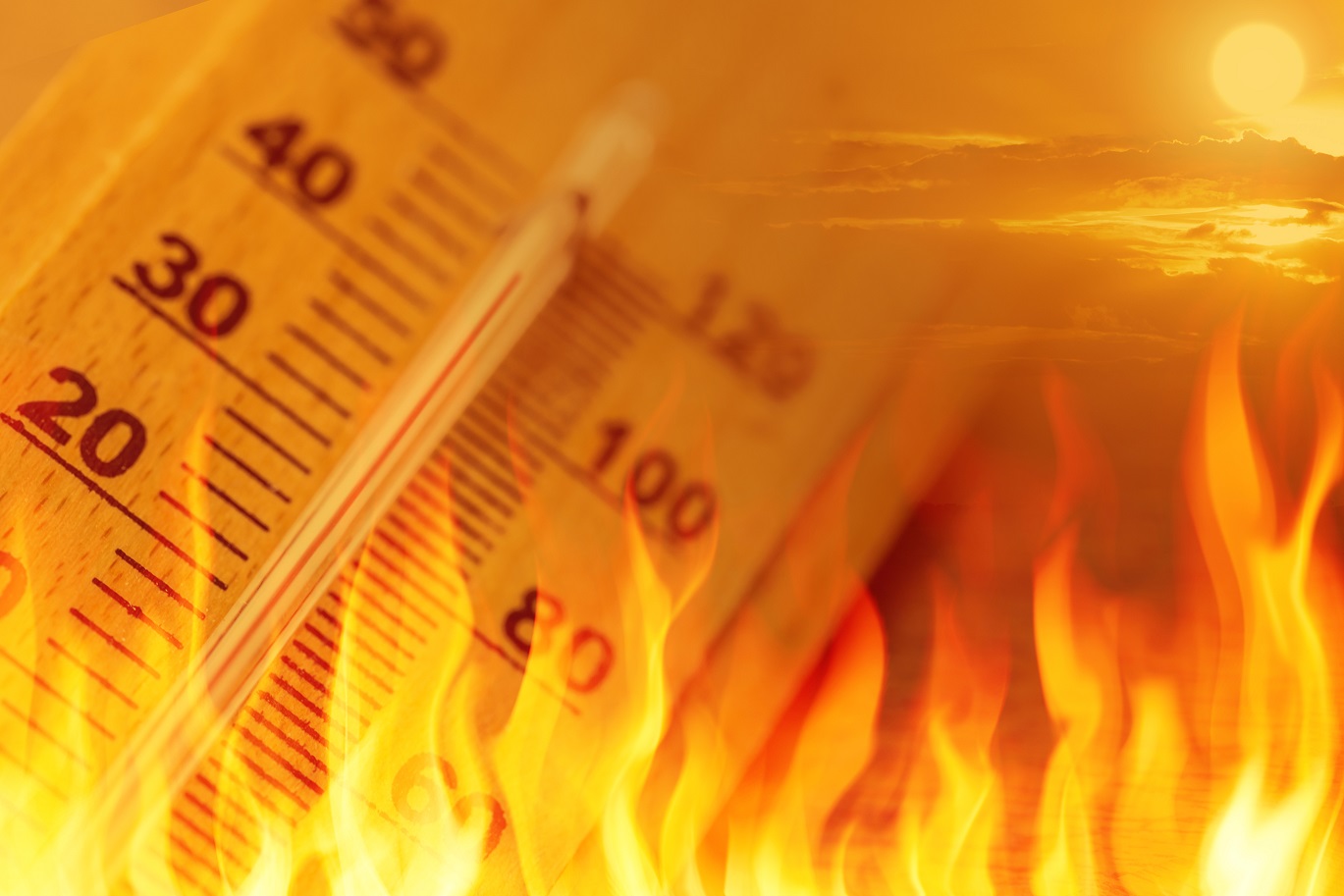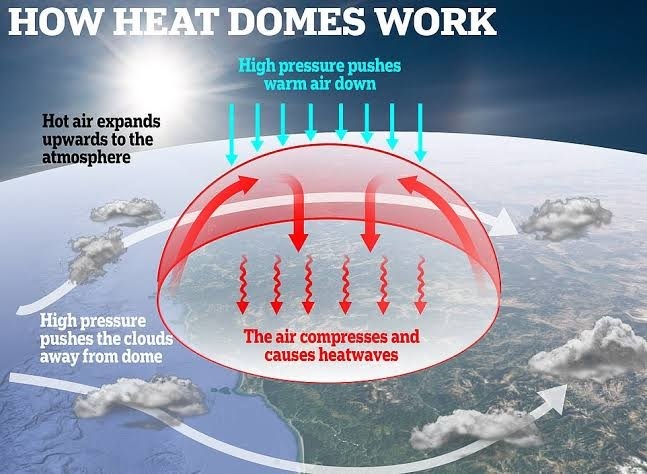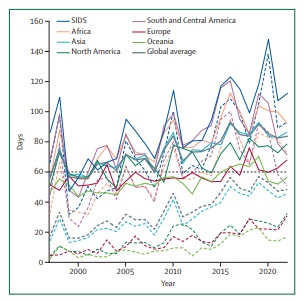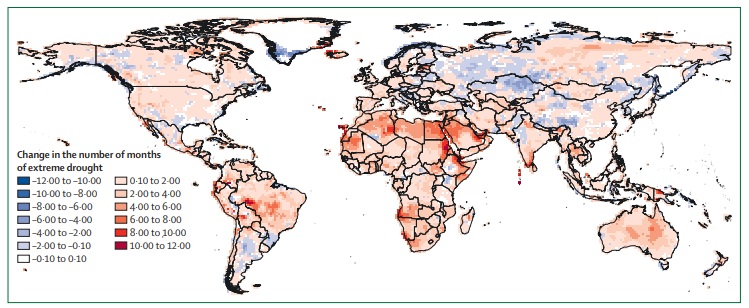
By Akerele Christabel
Climate predictions show hot and dry days ahead with heat and drought levels expected to rise.
The World Economic Forum’s Global Risks report for 2024 has listed worsening heatwaves as part of a trio of climate disasters that are likely to have the biggest impact on human health. By 2050, according to this report, heat waves are forecast to account for nearly 1.6 million deaths. This will mostly play out in the highest-risk areas, including the US, Central America, southern and western Africa, the Middle East, India, South-East Asia and northern Australia, with those regions projected to seee their heat exposure go up 12 to 38 times.
Prior to this bleak prediction, the Lancet countdown predicted that the heat will worsen year after year, until by 2050, deaths from temperatures will multiply to a point that could become catastrophic for the population. The Lancet Countdown is an international research collaboration that independently monitors the changing health impacts of climate change and new opportunities for climate action. This report brought together 114 scientists and health professionals from 52 research institutions and UN agencies globally to offer its most comprehensive assessment to date.
Heat waves begin with a high-pressure system (also known as an anticyclone), where atmospheric pressure above an area builds up. That creates a sinking column of air that compresses, heats up, and oftentimes dries out. The sinking air acts as a cap or heat dome, trapping the latent heat already absorbed by the landscape. The high-pressure system ends up pushing out cooler, fast-moving air currents and squeezes clouds away, a phenomenon which gives the sun an unobstructed line of sight to the ground. Consequently, the ground, whether it is made of soil, sand, concrete, or asphalt, bakes in the sunlight, and in the long days and short nights of summer, heat energy quickly accumulates and temperatures rise.
Heat waves are especially common in areas that are already arid, like the desert Southwest, and at high altitudes where high-pressure systems readily form. Moisture in the ground can blunt the effects of heat, the way evaporating sweat can cool the body. But when there’s little water in the ground, in waterways, and in vegetation, there isn’t as much to soak up the heat besides the air itself. Urban areas worsen this warming. As roads, parking lots, and buildings cover natural landscapes, some cities like Los Angeles and Dallas end up absorbing more heat than their surroundings and can become as much as 20°F warmer. This is a phenomenon known as the urban heat island effect

Lancet Countdown further reports that, in 2023, the world experienced the highest global temperatures in more than 100,000 years, and heat records were broken on all continents during 2022. Adults over 65 years of age and infants under 1 year of age , for whom extreme heat can be particularly deadly, they are now exposed to twice as many heat wave days compared to 1986-2005.
Rapidly advancing detection and attribution science shows that more than 60% of extremely high temperature days in 2020 were more than twice as likely due to human-caused climate change. Climate change caused by greenhouse gases from burning fossil fuels is poised to make heat waves longer, more intense, and more frequent. Humanity’s hunger for fossil fuels is making individual disasters worse.The burning of fossil fuels adds greenhouse gases to the atmosphere, which traps more heat energy and pushes up average temperatures which, in turn, also pushes up extreme temperatures.

Heat waves are increasingly prevalent across the globe, affecting the body’s cooling system. Prolonged periods of heat can lead to a multitude of health issues, including heat exhaustion and electrolyte imbalances. Poorer populations are unfairly affected owing to their limited access to freshwater and air conditioning.
High temperatures increase the likelihood of heat exhaustion and heat stroke. They can raise blood pressure, make certain medications less effective, and worsen neurological conditions like multiple sclerosis. Air pollution also gets worse as rising temperatures increase the rate of formation of hazards like ozone. Such pollutants in turn exacerbate heart and lung problems.
Also, the rise in nighttime temperatures caused by the rising heatwave is particularly worrisome for public health. Without much overnight cooling, people living through a heat wave experience higher cumulative heat stress, increasing risks of problems like dehydration and disrupting sleep, which can further worsen exhaustion and stress from high temperatures.
Elderly people and very young children face some of the highest risks from extreme heat. People with certain health conditions, like high blood pressure and breathing difficulties, also face greater harm. But even otherwise healthy people can suffer from heat waves if they are exposed for long durations, such as those working outdoors in agriculture and construction.

The World Economic Forum suggests that two areas need particular attention to make humanity resilient to the rising temperatures. These areas may be either preventing or reducing the health impacts of climate change and the ability to recover quickly from a climate event when it does happen.
This requires a conjoined effort from governments, policymakers, the life sciences industry and the healthcare sector itself. The report further concludes that governments and industry must do their utmost to cut greenhouse gas emissions to prevent a downward spiral in the first place. Increasing energy efficiency can relieve stress on the power grid, and adding power sources that do not require active cooling like wind and solar can boost capacity without adding greenhouse gas emissions.









Cancel anytime


Using our website
You may use the The Middle Land website subject to the Terms and Conditions set out on this page. Visit this page regularly to check the latest Terms and Conditions. Access and use of this site constitutes your acceptance of the Terms and Conditions in-force at the time of use.
Intellectual property
Names, images and logos displayed on this site that identify The Middle Land are the intellectual property of New San Cai Inc. Copying any of this material is not permitted without prior written approval from the owner of the relevant intellectual property rights.
Requests for such approval should be directed to the competition committee.
Please provide details of your intended use of the relevant material and include your contact details including name, address, telephone number, fax number and email.
Linking policy
You do not have to ask permission to link directly to pages hosted on this website. However, we do not permit our pages to be loaded directly into frames on your website. Our pages must load into the user’s entire window.
The Middle Land is not responsible for the contents or reliability of any site to which it is hyperlinked and does not necessarily endorse the views expressed within them. Linking to or from this site should not be taken as endorsement of any kind. We cannot guarantee that these links will work all the time and have no control over the availability of the linked pages.
Submissions
All information, data, text, graphics or any other materials whatsoever uploaded or transmitted by you is your sole responsibility. This means that you are entirely responsible for all content you upload, post, email or otherwise transmit to the The Middle Land website.
Virus protection
We make every effort to check and test material at all stages of production. It is always recommended to run an anti-virus program on all material downloaded from the Internet. We cannot accept any responsibility for any loss, disruption or damage to your data or computer system, which may occur while using material derived from this website.
Disclaimer
The website is provided ‘as is’, without any representation or endorsement made, and without warranty of any kind whether express or implied.
Your use of any information or materials on this website is entirely at your own risk, for which we shall not be liable. It is your responsibility to ensure any products, services or information available through this website meet your specific requirements.
We do not warrant the operation of this site will be uninterrupted or error free, that defects will be corrected, or that this site or the server that makes it available are free of viruses or represent the full functionality, accuracy and reliability of the materials. In no event will we be liable for any loss or damage including, without limitation, loss of profits, indirect or consequential loss or damage, or any loss or damages whatsoever arising from the use, or loss of data, arising out of – or in connection with – the use of this website.
Last Updated: September 11, 2024
New San Cai Inc. (hereinafter “The Middle Land,” “we,” “us,” or “our”) owns and operates www.themiddleland.com, its affiliated websites and applications (our “Sites”), and provides related products, services, newsletters, and other offerings (together with the Sites, our “Services”) to art lovers and visitors around the world.
This Privacy Policy (the “Policy”) is intended to provide you with information on how we collect, use, and share your personal data. We process personal data from visitors of our Sites, users of our Services, readers or bloggers (collectively, “you” or “your”). Personal data is any information about you. This Policy also describes your choices regarding use, access, and correction of your personal information.
If after reading this Policy you have additional questions or would like further information, please email at middleland@protonmail.com.
PERSONAL DATA WE COLLECT AND HOW WE USE IT
We collect and process personal data only for lawful reasons, such as our legitimate business interests, your consent, or to fulfill our legal or contractual obligations.
Information You Provide to Us
Most of the information Join Talents collects is provided by you voluntarily while using our Services. We do not request highly sensitive data, such as health or medical information, racial or ethnic origin, political opinions, religious or philosophical beliefs, trade union membership, etc. and we ask that you refrain from sending us any such information.
Here are the types of personal data that you voluntarily provide to us:
As a registered users or customers, you may ask us to review or retrieve emails sent to your business. We will access these emails to provide these services for you.
We use the personal data you provide to us for the following business purposes:
Information Obtained from Third-Party Sources
We collect and publish biographical and other information about users, which we use to promote the articles and our bloggers who use our sites. If you provide personal information about others, or if others give us your information, we will only use that information for the specific reason for which it was provided.
Information We Collect by Automated Means
Log Files
The site uses your IP address to help diagnose server problems, and to administer our website. We use your IP addresses to analyze trends and gather broad demographic information for aggregate use.
Every time you access our Site, some data is temporarily stored and processed in a log file, such as your IP addresses, the browser types, the operating systems, the recalled page, or the date and time of the recall. This data is only evaluated for statistical purposes, such as to help us diagnose problems with our servers, to administer our sites, or to improve our Services.
Do Not Track
Your browser or device may include “Do Not Track” functionality. Our information collection and disclosure practices, and the choices that we provide to customers, will continue to operate as described in this Privacy Policy, whether or not a “Do Not Track” signal is received.
HOW WE SHARE YOUR INFORMATION
We may share your personal data with third parties only in the ways that are described in this Privacy Policy. We do not sell, rent, or lease your personal data to third parties, and We does not transfer your personal data to third parties for their direct marketing purposes.
We may share your personal data with third parties as follows:
There may be other instances where we share your personal data with third parties based on your consent.
HOW WE STORE AND SECURE YOUR INFORMATION
We retain your information for as long as your account is active or as needed to provide you Services. If you wish to cancel your account, please contact us middleland@protonmail.com. We will retain and use your personal data as necessary to comply with legal obligations, resolve disputes, and enforce our agreements.
All you and our data are stored in the server in the United States, we do not sales or transfer your personal data to the third party. All information you provide is stored on a secure server, and we generally accepted industry standards to protect the personal data we process both during transmission and once received.
YOUR RIGHTS/OPT OUT
You may correct, update, amend, delete/remove, or deactivate your account and personal data by making the change on your Blog on www.themiddleland.com or by emailing middleland@protonmail.com. We will respond to your request within a reasonable timeframe.
You may choose to stop receiving Join Talents newsletters or marketing emails at any time by following the unsubscribe instructions included in those communications, or you can email us at middleland@protonmail.com
LINKS TO OTHER WEBSITES
The Middle Land include links to other websites whose privacy practices may differ from that of ours. If you submit personal data to any of those sites, your information is governed by their privacy statements. We encourage you to carefully read the Privacy Policy of any website you visit.
NOTE TO PARENTS OR GUARDIANS
Our Services are not intended for use by children, and we do not knowingly or intentionally solicit data from or market to children under the age of 18. We reserve the right to delete the child’s information and the child’s registration on the Sites.
PRIVACY POLICY CHANGES
We may update this Privacy Policy to reflect changes to our personal data processing practices. If any material changes are made, we will notify you on the Sites prior to the change becoming effective. You are encouraged to periodically review this Policy.
HOW TO CONTACT US
If you have any questions about our Privacy Policy, please email middleland@protonmail.com
The Michelin brothers created the guide, which included information like maps, car mechanics listings, hotels and petrol stations across France to spur demand.
The guide began to award stars to fine dining restaurants in 1926.
At first, they offered just one star, the concept was expanded in 1931 to include one, two and three stars. One star establishments represent a “very good restaurant in its category”. Two honour “excellent cooking, worth a detour” and three reward “exceptional cuisine, worth a
Thank you for your participation,
please Log in or Sign up to Vote

123Sign in to your account